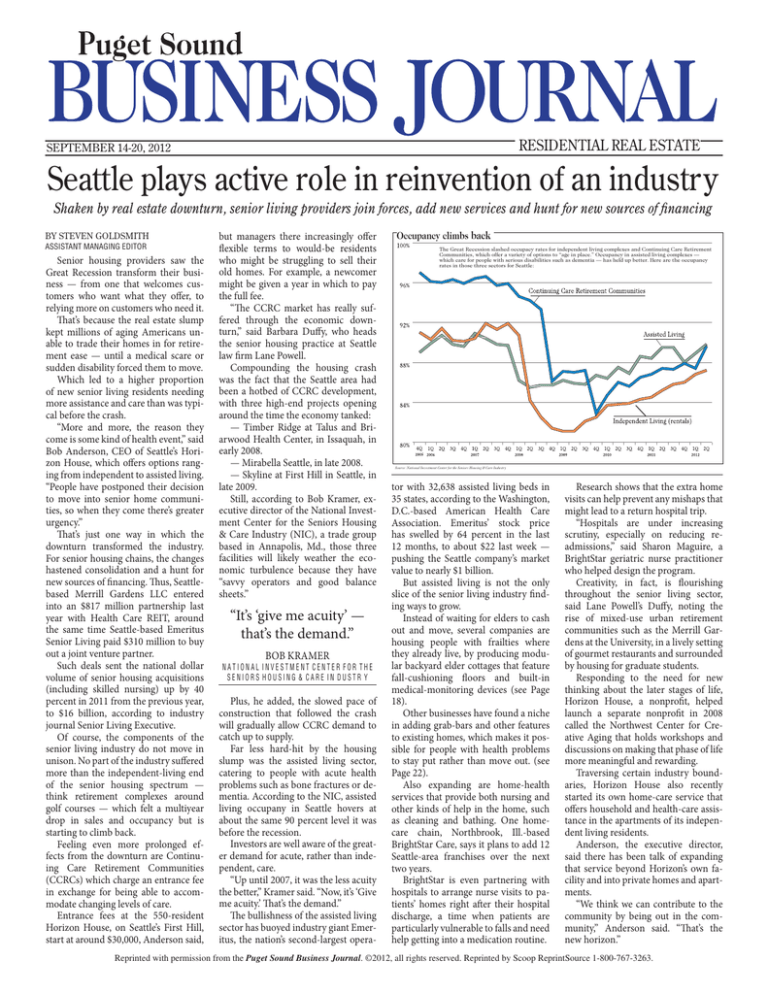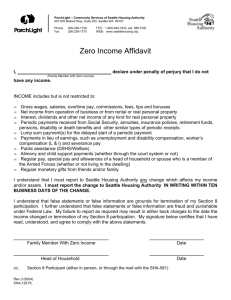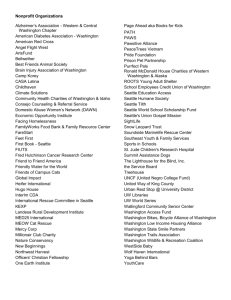Seattle plays active role in reinvention of an industry
advertisement

RESIDENTIAL REAL ESTATE SEPTEMBER 14-20, 2012 Seattle plays active role in reinvention of an industry Shaken by real estate downturn, senior living providers join forces, add new services and hunt for new sources of financing BY STEVEN GOLDSMITH ASSISTANT MANAGING EDITOR Senior housing providers saw the Great Recession transform their business — from one that welcomes customers who want what they offer, to relying more on customers who need it. That’s because the real estate slump kept millions of aging Americans unable to trade their homes in for retirement ease — until a medical scare or sudden disability forced them to move. Which led to a higher proportion of new senior living residents needing more assistance and care than was typical before the crash. “More and more, the reason they come is some kind of health event,” said Bob Anderson, CEO of Seattle’s Horizon House, which offers options ranging from independent to assisted living. “People have postponed their decision to move into senior home communities, so when they come there’s greater urgency.” That’s just one way in which the downturn transformed the industry. For senior housing chains, the changes hastened consolidation and a hunt for new sources of financing. Thus, Seattlebased Merrill Gardens LLC entered into an $817 million partnership last year with Health Care REIT, around the same time Seattle-based Emeritus Senior Living paid $310 million to buy out a joint venture partner. Such deals sent the national dollar volume of senior housing acquisitions (including skilled nursing) up by 40 percent in 2011 from the previous year, to $16 billion, according to industry journal Senior Living Executive. Of course, the components of the senior living industry do not move in unison. No part of the industry suffered more than the independent-living end of the senior housing spectrum — think retirement complexes around golf courses — which felt a multiyear drop in sales and occupancy but is starting to climb back. Feeling even more prolonged effects from the downturn are Continuing Care Retirement Communities (CCRCs) which charge an entrance fee in exchange for being able to accommodate changing levels of care. Entrance fees at the 550-resident Horizon House, on Seattle’s First Hill, start at around $30,000, Anderson said, but managers there increasingly offer flexible terms to would-be residents who might be struggling to sell their old homes. For example, a newcomer might be given a year in which to pay the full fee. “The CCRC market has really suffered through the economic downturn,” said Barbara Duffy, who heads the senior housing practice at Seattle law firm Lane Powell. Compounding the housing crash was the fact that the Seattle area had been a hotbed of CCRC development, with three high-end projects opening around the time the economy tanked: — Timber Ridge at Talus and Briarwood Health Center, in Issaquah, in early 2008. — Mirabella Seattle, in late 2008. — Skyline at First Hill in Seattle, in late 2009. Still, according to Bob Kramer, executive director of the National Investment Center for the Seniors Housing & Care Industry (NIC), a trade group based in Annapolis, Md., those three facilities will likely weather the economic turbulence because they have “savvy operators and good balance sheets.” “It’s ‘give me acuity’ — that’s the demand.” BOB KRAMER NATIONAL INVESTMENT CENTER FOR THE SENIORS HOUSING & CARE IN DUSTR Y Plus, he added, the slowed pace of construction that followed the crash will gradually allow CCRC demand to catch up to supply. Far less hard-hit by the housing slump was the assisted living sector, catering to people with acute health problems such as bone fractures or dementia. According to the NIC, assisted living occupany in Seattle hovers at about the same 90 percent level it was before the recession. Investors are well aware of the greater demand for acute, rather than independent, care. “Up until 2007, it was the less acuity the better,” Kramer said. “Now, it’s ‘Give me acuity.’ That’s the demand.” The bullishness of the assisted living sector has buoyed industry giant Emeritus, the nation’s second-largest opera- Occupancy climbs back the great recession slashed occupacy rates for independent living complexes and Continuing Care retirement Communities, which offer a variety of options to “age in place.” occupancy in assisted living complexes — which care for people with serious disabilities such as dementia — has held up better. Here are the occupancy rates in those three sectors for seattle: Source: National Investment Center for the Seniors Housing & Care Industry tor with 32,638 assisted living beds in 35 states, according to the Washington, D.C.-based American Health Care Association. Emeritus’ stock price has swelled by 64 percent in the last 12 months, to about $22 last week — pushing the Seattle company’s market value to nearly $1 billion. But assisted living is not the only slice of the senior living industry finding ways to grow. Instead of waiting for elders to cash out and move, several companies are housing people with frailties where they already live, by producing modular backyard elder cottages that feature fall-cushioning floors and built-in medical-monitoring devices (see Page 18). Other businesses have found a niche in adding grab-bars and other features to existing homes, which makes it possible for people with health problems to stay put rather than move out. (see Page 22). Also expanding are home-health services that provide both nursing and other kinds of help in the home, such as cleaning and bathing. One homecare chain, Northbrook, Ill.-based BrightStar Care, says it plans to add 12 Seattle-area franchises over the next two years. BrightStar is even partnering with hospitals to arrange nurse visits to patients’ homes right after their hospital discharge, a time when patients are particularly vulnerable to falls and need help getting into a medication routine. Research shows that the extra home visits can help prevent any mishaps that might lead to a return hospital trip. “Hospitals are under increasing scrutiny, especially on reducing readmissions,” said Sharon Maguire, a BrightStar geriatric nurse practitioner who helped design the program. Creativity, in fact, is flourishing throughout the senior living sector, said Lane Powell’s Duffy, noting the rise of mixed-use urban retirement communities such as the Merrill Gardens at the University, in a lively setting of gourmet restaurants and surrounded by housing for graduate students. Responding to the need for new thinking about the later stages of life, Horizon House, a nonprofit, helped launch a separate nonprofit in 2008 called the Northwest Center for Creative Aging that holds workshops and discussions on making that phase of life more meaningful and rewarding. Traversing certain industry boundaries, Horizon House also recently started its own home-care service that offers household and health-care assistance in the apartments of its independent living residents. Anderson, the executive director, said there has been talk of expanding that service beyond Horizon’s own facility and into private homes and apartments. “We think we can contribute to the community by being out in the community,” Anderson said. “That’s the new horizon.” Reprinted with permission from the Puget Sound Business Journal. ©2012, all rights reserved. Reprinted by Scoop ReprintSource 1-800-767-3263.




